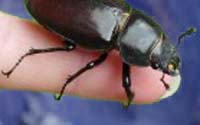STAG BEETLES NEED HELP
The People’s Trust for Endangered Species (PTES) is urging gardeners, as well as managers of urban green spaces and country parks, to build nature’s equivalent of skyscrapers in order to provide homes for one of Britain’s largest, charismatic and most threatened beetles – the stag beetle (Lucanus cervus).
Dead and decaying wood might be an unsightly garden feature to some, but for many of the country’s insects such as the stag beetle, it is home. Stag beetle larvae live for up to a staggering seven years in decaying wood such as log piles and tree stumps where they feed on the rotten timber, before emerging as beetles to breed during their short adult life span.
Stag beetles do not travel very far and so the number found in an area depends on the availability of habitat at the time that the female laid her eggs several years earlier. An adult female will lay her eggs where she emerged from if there is sufficient dead wood, otherwise she needs to find somewhere else.
Our tidy, decked gardens can therefore threaten these vulnerable insects as places for them to shelter are lost or become isolated, leaving fewer suitable areas for female beetles to lay their eggs.
However, a simple and effective way of helping stag beetles is to make sure they have a good supply of dead wood and can travel around easily by leaving tree stumps in situ or creating “stepping stones” by partially burying a vertical log pile.
Jill Nelson, Chief Executive of PTES says: “Despite their ferocious-looking, antler-like mandibles, stag beetles are harmless and can actually be a gardener’s friend by helping recycle wood. Burying a vertical log pile is something that anyone can do to help increase breeding sites for them. You don’t have to have a huge garden to help stag beetles and other wildlife, as even a single log can provide shelter and food.”
Top tips for building your stepping stones for stags
- Partially bury logs vertically in the soil, up to 50cm deep
- If possible, site logs in partial shade to prevent them from drying out
- Allow plants to grow over logs as this will retain moisture and provide shade
- Wood from oak, beech or fruit trees support the richest insect communities
- Avoid using polythene sheeting to control weeds as beetles can get trapped underneath
Everything you never knew you never knew about Stag Beetles!
Latin name: Lucanus cervus
Common name: Stag beetle
Size: Adult males can vary in size from 35mm to 75mm long and have large antler-like mandibles; females are smaller at between 30mm to 50mm long, with normal sized mandibles
Distinguishing features: Males have antler-like mandibles (jaws) which are used in courtship displays and to wrestle with other male beetles; both sexes have a shiny black head and thorax (chest) and their elytra (wing cases) are chestnut brown
Habitat: Woodland edges, but also parks and gardens where there are hedgerows, tree stumps and logs
Diet: Larvae feed on decaying wood and roots. It is thought that adults feed on tree sap or nothing at all.
Life-span: Larvae live for at least four years underground before turning into a pupa. Adult beetles develop inside these pupal cases overwintering as an adult beetle which then emerges in spring. They live as adults for only a few months in the summer in order to mate.
Breeding: Males emerge in May or June, depending on the weather, followed shortly after by the females. Males take flight on warm summer evenings while they look for a mate. Females are more often seen at ground level, looking for suitable egg-laying sites.
Distribution: Stag beetles are relatively widespread in southeast England and are also found in the Severn Valley, East Anglia and coastal areas of the southwest, elsewhere they are extremely rare or not present at all
Conservation status: In the UK, the species is classed as ‘Nationally Scarce’, is listed on Schedule 5 of the Wildlife & Countryside Act, making it illegal to trade the species without a licence, and is also a priority Biodiversity Action Plan species. The beetle is also listed on Schedule II of the EC Habitats Directive as it is rare throughout much of Europe. It is known to have become extinct in Latvia and Denmark
Further Information:
Visit www.ptes.org/stagbeetles to download full, free instructions on creating your own stepping stones for stags and to register your log pile.

